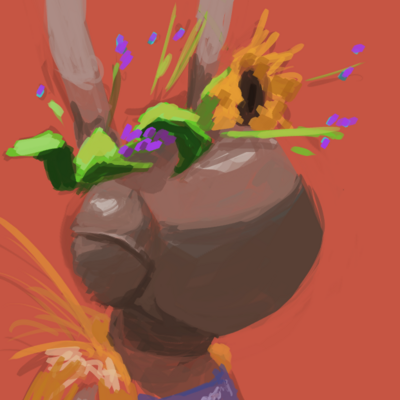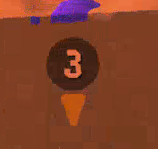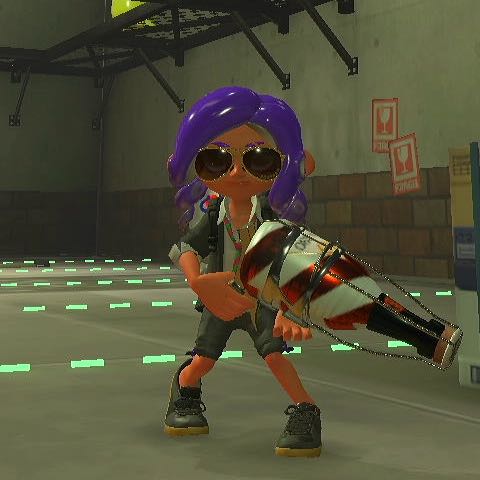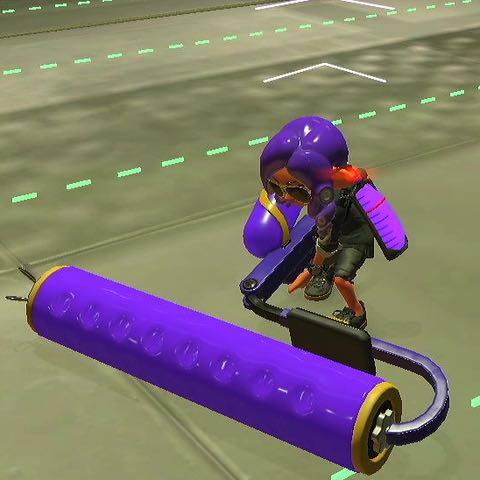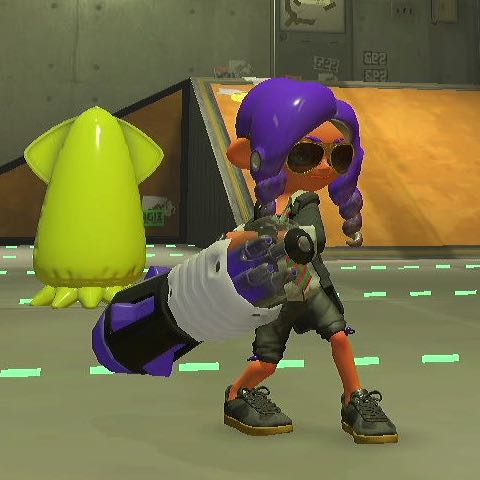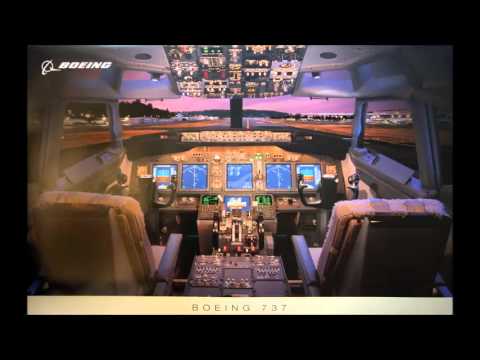Indicators in Splatoon 3 Clam Blitz
Codl, an e-friend on Mastodon, had a question about how clam count indicators worked in Splatoon 3 Clam Blitz:
There’s some important context for why I found this question really interesting.
What is Splatoon?

Splatoon is a series of third-person shooters from Nintendo. You play a kid, sometimes a squid1, rendered with considerable artistic license, either locked in a solo or player-vs-enemy (PvE) existential struggle of some sort, or a player-vs-player contest for fun and in-game prizes. Players can walk and shoot ink out of cartoonish weapons (many like repurposed real-world gadgets) in kid form, swim and re-up on ink in squid form, and return to the spawn point after being blasted with too much opponent ink (“splatted,” not killed) in ghost form.
Many Splatoon weapons are inspired by real-world objects.
In each stage (map), most floors and some walls accept ink. On un-inked ground, you can walk as a kid or slowly push yourself in squid form. You can walk fast and swim even faster in friendly ink. You take damage in opponents’ ink, but can still move. It’s always valuable to spread ink (from a gun, grenade, or special weapon) where you or a teammate might want to move, and your opponents are trying to do the same.
If you get too much opponents’ ink on you (either from their attacks or just from spending too much time in their ink) you get splatted with a big pop, a surprised exclamation, and a corona of the opponents’ ink. Outside of the PvE Salmon Run mode, your ghost makes it back to your team’s base area to respawn in a few seconds.
Splatoon doesn’t look like other big multiplayer shooters. The inks are bright and vivid, splashy and wet. Once you’re in the thick of a match, there’s an incredible amount of activity to keep track of, because matches only last a few minutes and even when you’re passing through uncontested territory you have to pay attention to the goal of the current game mode.
The unranked2 “Turf War” mode is straightforward: the team that’s got more of the floor in their ink at the end of three minutes wins.
There are four ranked3 modes too. “Splat Zones” require teams to keep one or more of the z0nes on the map in their color for a period of time. “Tower Control” require teams to stand on a mobile tower to move it into the opponents’ base to win. “Rainmaker” is football (either kind) but the football is a slow-charging bazooka you deliver to the opponents’ goal to win.
And finally, “Clam Blitz” is complicated. It was introduced several months in to Splatoon 2 and had an official explainer right before release. Teams gather clams from around the stage. When a player has enough (ten in Splatoon 2, eight in Splatoon 3) they form a “power clam.” Once a power clam is in play, the goal is to put it in the opponents’ basket, breaking the barrier. With the barrier down, attackers can throw any clams (including power clams) in for points. After a while, the barrier goes back up, and the team defending it gets a free power clam. There’s a complex ebb and flow to it, an extra layer of chaos to an already frantic game.
This diversity of modes (I haven’t even talked about Salmon Run or Tricolor Battles) is tricky to inform players about.
Interface Design and Human Factors
An octoling painting a part of Scorch Gorge bright pink with the N-Zap. After their ink depletes, they morph from kid mode to swim mode, their ink tank disappearing in to the wet floor as they turn into an octopus, with a superimposed ink tank graphic appearing next to their swimming form.
You can categorize the way action games communicate state to the player based on diegesis. Seeing your ink tank empty on your octolings’ back is as diegetic as The Dude’s Credence tapes. It’s part of the same world the characters inhabit. Watching it refill as a UI element vaguely tethered to your swimming form is non-diegetic, much as “The Blue Danube” isn’t actually playing among spaceships in hard vacuum.
Splatoon uses both of these. When it’s viable to do so, state’s diegetic. Splat zones change highlighting around the edges when they change control, the tower and the rainmaker are both physical objects (and they can hurt you), and once you’ve picked up clams they follow you around in a little line. However, it’s not always viable, and some parts of the game rate non-diegetic UI. The tower, rainmaker, and power clams get a permanent overlaid icon on your screen no matter how far away they are.
This presents a problem. Splatoon 2 and 3 are for the Nintendo Switch, which ships with a 720p (1280x720) screen on the unit itself. The more expensive versions of the hardware (the original and OLED switches, not the lite switch) can dock to drive a 1080p (1920x1080) screen, but the design of the game has to work at 720p on a 5.5” screen. This puts a real damper on what you can show UI-wise. Elements have to be big to work at 5.5”, but too many of them won’t leave enough room to notice an opponent casting ripples as they swim in their team’s ink.
This has parallels with aviation. In the July/August 2020 issue of the FAA Safety Briefing, the article “Avoiding Information Overload” by Gene Trainor (PDF page 36) mentions how non-diegetic4 interfaces can cause problems:
For example, Automatic Dependent Surveillance-Broadcast (ADS-B), Helicopter Terrain Awareness and Warning Systems (HTAWS), and autopilot technologies have made flying easier and safer. The drawback is that these systems require concentration when quick decisions are needed.
The solution for this, as implemented on the Boeing 777 and described by Vincent Czaplyski in AOPA Pilot magazine is a Crew Alerting System (CAS) that filters and prioritizes warnings:
Just the right touch, however, and the crew’s situational awareness will be maximized, which is what warning systems are really all about. For this reason, some non-critical alerts on the 777 are inhibited at the beginning of the takeoff roll until the aircraft has reached a safe altitude. This is to prevent pilots from initiating high-speed aborted takeoffs for minor problems that could be easily taken care of once safely airborne.
[…]
What happens if two or more critical conditions are detected simultaneously? CAS will issue alerts in a predetermined priority sequence. […] Shortly after takeoff, GPWS senses that your aircraft has begun to sink toward rising terrain. At the same time, the reactive wind shear warning system detects that the twinjet has encountered a microburst, just as the right engine catches on fire. To make matters worse, another aircraft is approaching on a collision course, something which causes TCAS to generate a resolution advisory (RA), warning of the traffic conflict. […] According to Boeing spokesman Brian Kelly, voice warnings will sound in quick succession for wind shear, GPWS, and TCAS, in that order. While this is happening, the engine fire will trigger a fire bell and an EICAS text message simultaneously.
Competitive action games can absolutely put you at or beyond the limits of your ability to process and act on information. That’s why they’re fun! However, presenting that fun to a wide variety of players with a huge range of skill levels requires careful consideration of how information is communicated to players.
Clam Discs
An octoling painting a part of Scorch Gorge yellow with a brush. They walk into several clams on the ground, which, on contact, play a musical tone, pop up before following behind them, at which point a number pops and increments behind the octoling’s head.
Going back to the original Clam Blitz thing, as players get their hands on clams, sometimes non-diegetic numbers show up above them, sometimes dark/de-emphasized and someimes bright and vivid. We wanted to figure out what caused the numbers to show up, in which flavor of disc. That probably required two people on the same team, and someone on the opponent team.
So that’s what we did! Splatoon 3 lets you set up a “private battle” in which you’re not bound by the game’s schedule or matchmaking. Among the different game modes there is a “recon” option, which configures the map and UI for a given mode, but sets the timer out to an hour so you can mess around and do whatever.
We went with Clam Blitz and recon at Wahoo World.
After a couple minutes, I’d mostly landed on a hypothesis that you could sum up disc color with a big spreadsheet, with rows of your own clams and columns of the other friendly player’s clams. This fell apart almost immediately, because there are too many variables in play. We’re pretty sure power clams of either team affect visibility (four clams are less interesting if someone on your team has a power clam), basket state probably affects it (you can’t score if opponents are currently scoring), and so on.
So this is where the speculation starts, and my speculation is mostly based around how I’d try to implement it, from my background of playing around with WebGL in Three.js a few times and knowing nothing about efficiently implementing real-time games.
There needs to be a general concept
(abstract class) of an indicator that follows
world objects. This is used to show
nametags, the rainmaker and tower icons, etc.
I’d call it FollowIndicator.
Specializations (subclasses) of this concept
provide a thing to actually draw,
and communicate up to some higher level code
their priority.
In the case of a ClamInventoryIndicator,
it’d update its drawn representation with the right number
(or the power clam icon) every frame,
and every few frames, update its priority.
Why not priority every frame? I suspect it’s complicated to figure out that priority. It can’t purely be based on clam count, since having three clams when nobody has any is more interesting than having five clams when two teammates have a power clam.
Additionally, there seems to be some stickiness in the
prioritization of these that means
newly-low-priority indicators stick around for a bit,
but I could see that being the responsibility of
an IndicatorCollection.
The collection would have a budget of how many
indicators should be displayed,
possibly holding newly-low-priority
ones for a while.
Conclusion
This is, of course, all speculation, and it feels like the kind of reverse engineering that would both be a lot of complex work and not be particularly useful from a minmaxing multiplayer stuff based on data mining perspective.
I found it at least interesting to think about though, and I hope you got something from it too.
Credits
The header font is “Project Paintball” by JapanYoshi / theFIZZYnator. Unreadable decorative font is “Inkling” 2.0 by frozenpandaman.
Thanks codl for nerd sniping me with this, and ctrl-alt-dog/cinnamon for helping out with the experiment.
-
or an octopus ↩
-
it’s absolutely tracking how good you are, just not giving you a visible rank to fret about ↩
-
in Splatoon 3 the battles that establish a meritocratic hierarchy among players are called “Anarchy Battles” ↩
-
you could absolutely make the argument that because these systems and interfaces inhabit our world, that they are in fact diegetic, but i couldn’t think of a better terminology to use ↩
-
Big Clown gave me $6 for each time I said “clowned on” ↩
